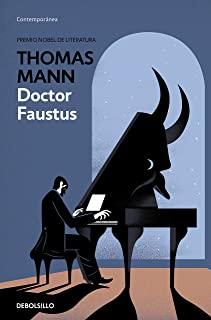
description
0Una reinterpretación del gran mito inmortalizado por Goethe.
Un reflejo de la sociedad moderna. La última gran novela de Thomas Mann es una reinterpretación del mito de Fausto. Su protagonista, Adrian Leverkühn, es un compositor brillante, asà como un hombre solitario y exigente. Su obra, una música nueva, rompedora, radical y de ritmo acelerado, parece estar al filo de lo imposible. A pesar del éxito, Adrian aspira a más hasta el punto de vender su alma y renunciar a cualquier posibilidad de amar. Doctor Faustus, una de las obras más profundas del autor, reflexiona acerca de la figura del genio, al mismo tiempo que propone el mito de fausto como un reflejo de la realidad de su tiempo. ENGLISH DESCRIPTION The new translation, by the masterly John E. Woods, of one of Thomas Mann's most famous and important novels: his modern reworking of the Faust legend, in which twentieth-century Germany sells its soul to the devil. Mann's protagonist, Adrian Leverkühn, is one of the most significant characters in the literature of our era, for it is in him that Mann centers the tragedy of Germany's seduction by evil. This modern Faust is a great artist: Leverkühn is a musical genius who trades body and soul in a Mephistophelian bargain for twenty-four years of triumph as the world's greatest composer. He is isolated, brilliant, a radical experimenter who both plays and thinks at the very edges of artistic possibility. The story of his life becomes an apocalyptic narrative of his country's moral collapse as it surges into the catastrophe of World War II. No simple symbolic figure, Leverkühn is himself, almost paradoxically, a morally driven man in the vortex of an entire culture's self-destruction. Through the wonderful--and terrible--story of Leverkühn's life and death, Mann not only gave us his most profound writing on the very nature and heart of all art--how it is created and how it impinges on every aspect of our experience: artistic, religious, political, sexual, psychological--but also forced his countrymen (the novel was first published fifty years ago, in 1947) to come face-to-face with how they had fallen prey to all that was most lethal in their heritage.
Un reflejo de la sociedad moderna. La última gran novela de Thomas Mann es una reinterpretación del mito de Fausto. Su protagonista, Adrian Leverkühn, es un compositor brillante, asà como un hombre solitario y exigente. Su obra, una música nueva, rompedora, radical y de ritmo acelerado, parece estar al filo de lo imposible. A pesar del éxito, Adrian aspira a más hasta el punto de vender su alma y renunciar a cualquier posibilidad de amar. Doctor Faustus, una de las obras más profundas del autor, reflexiona acerca de la figura del genio, al mismo tiempo que propone el mito de fausto como un reflejo de la realidad de su tiempo. ENGLISH DESCRIPTION The new translation, by the masterly John E. Woods, of one of Thomas Mann's most famous and important novels: his modern reworking of the Faust legend, in which twentieth-century Germany sells its soul to the devil. Mann's protagonist, Adrian Leverkühn, is one of the most significant characters in the literature of our era, for it is in him that Mann centers the tragedy of Germany's seduction by evil. This modern Faust is a great artist: Leverkühn is a musical genius who trades body and soul in a Mephistophelian bargain for twenty-four years of triumph as the world's greatest composer. He is isolated, brilliant, a radical experimenter who both plays and thinks at the very edges of artistic possibility. The story of his life becomes an apocalyptic narrative of his country's moral collapse as it surges into the catastrophe of World War II. No simple symbolic figure, Leverkühn is himself, almost paradoxically, a morally driven man in the vortex of an entire culture's self-destruction. Through the wonderful--and terrible--story of Leverkühn's life and death, Mann not only gave us his most profound writing on the very nature and heart of all art--how it is created and how it impinges on every aspect of our experience: artistic, religious, political, sexual, psychological--but also forced his countrymen (the novel was first published fifty years ago, in 1947) to come face-to-face with how they had fallen prey to all that was most lethal in their heritage.
member goods
No member items were found under this heading.
Return Policy
All sales are final
Shipping
No special shipping considerations available.
Shipping fees determined at checkout.







